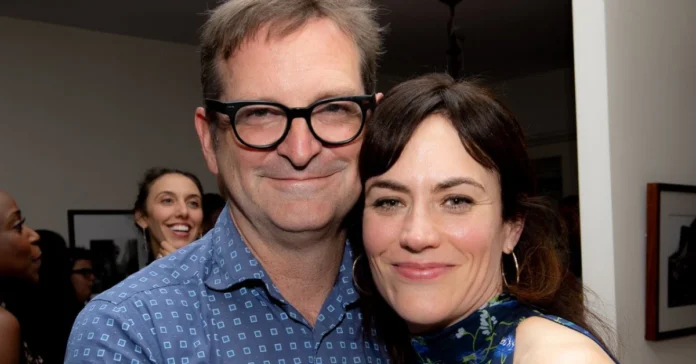Paul Ratliff wasn’t just the husband of a famous actress. He built an impressive career spanning therapy, design strategy, and business innovation before passing in 2021.
Born and raised in Los Angeles, California, Ratliff created a unique professional path combining psychology and corporate innovation. His work touched many lives through his therapy practice and business consulting.
Paul Ratliff’s Career Path
From Actor to Business Consultant
Paul Ratliff started his career with minor acting roles in the 1980s. He appeared in shows like “Cheers” and “General Hospital,” along with the film “To Be or Not to Be.”
But acting wasn’t his final destination. Ratliff transformed his career, becoming a design strategist and innovation consultant for major companies including Johnson & Johnson and Sapient.
Finding His True Calling in Therapy
Later in his career, Paul found his true passion as a licensed marriage and family therapist. He practiced at the Erika Malm Collective in New York, where he helped clients with anxiety, eating disorders, life transitions, and stress management.
His specialty areas included men’s issues and peer relationships. This work brought him fulfillment as he helped people navigate complex psychological challenges.
Marriage to Maggie Siff
Paul Ratliff married actress Maggie Siff in October 2012. Maggie was 38 at the time of their wedding.
Maggie Siff is best known for her roles in popular TV series like “Mad Men,” “Sons of Anarchy,” and “Billions.” While she maintained a high public profile, Paul preferred to stay behind the scenes.
Family Life
The couple welcomed their daughter, Lucy Ratliff, on April 14, 2014. They made their home in Brooklyn, New York, where they lived until Paul’s passing.
Unlike many celebrity couples, Paul and Maggie kept their family life private. Paul rarely appeared in interviews or made public statements about their relationship.
Professional Approach and Philosophy
Bridging Psychology and Business
What made Paul Ratliff stand out was his ability to blend psychology with design strategy. He applied ethnographic research methods to both corporate innovation and mental health practice.
His approach centered on understanding human behavior in real-world contexts. This unique perspective influenced both therapy practices and user experience design.
Client-Centered Therapy
As a therapist, Paul put his clients first. He developed holistic, client-centered therapy practices that addressed the whole person.
His background in design thinking likely influenced his therapy style. He worked to create personalized approaches for each individual rather than using one-size-fits-all methods.
Legacy and Influence
Professional Impact
Paul Ratliff’s career shows the value of interdisciplinary skills. He moved between corporate and clinical worlds with ease, bringing insights from each field to the other.
His work pioneered the integration of ethnographic research into product and service design. This approach continues to influence both business innovation and therapy practices today.
Personal Legacy
Despite being married to a public figure, Paul maintained his privacy and professional integrity. He served as a model for others on how to balance personal life with professional success.
His greatest legacy may be the lives he touched through his therapy practice. While his name wasn’t widely known, his impact on clients was significant.
Paul Ratliff’s Battle with Brain Cancer
Paul Ratliff passed away in December 2021 after fighting brain cancer. His death came after nearly a decade of marriage to Maggie Siff.
Despite his illness, he maintained his professional commitments as long as possible. His dedication to his work and family showed his character and determination.
Lessons from Paul Ratliff’s Career
Embracing Multiple Disciplines
Paul’s career path teaches us to value diverse experiences. He didn’t limit himself to one field but instead drew connections between psychology, business, and design.
This interdisciplinary approach made him more effective in each of his roles. It allowed him to see problems from multiple angles and develop creative solutions.
The Value of Empathy
Whether working as a therapist or business consultant, Paul placed high value on understanding people. His emphasis on empathy and real-world observation guided his work.
This human-centered approach is something professionals in any field can learn from. It reminds us that behind every business problem or psychological issue are real people with real needs.
Personal Life and Privacy
Maintaining Privacy
Despite being connected to a celebrity, Paul Ratliff kept a low public profile. He rarely attended high-profile events and, when he did, it was usually alongside Maggie Siff.
His choice to stay out of the spotlight allowed him to focus on his work and family. It also protected his professional reputation as a therapist.
Home and Lifestyle
Paul and Maggie made their home in Brooklyn, New York. While specific details about their property or lifestyle remain private, they lived comfortably as working professionals.
No public information exists about luxury items, cars, or specific investments owned by Paul Ratliff. His focus seemed to be on his work and family rather than material possessions.
Financial Aspects
Career Earnings
As both a therapist and consultant, Paul Ratliff likely earned a comfortable living. His income would have reflected typical earnings in these professional fields.
However, no reliable public estimates of his net worth exist. His earnings came primarily from his work as a therapist, consultant, and strategist.
Private Finances
Unlike many celebrities or public figures, Paul’s financial details remained private. There are no verifiable public figures for his net worth for any year.
This privacy policy about financial matters aligns with his overall approach to public life. He chose to keep personal details, including finances, out of public view.
The Intersection of Public and Private Life
Living With Celebrity
Being married to a well-known actress like Maggie Siff comes with unique challenges. Paul managed to support his wife’s career while maintaining his own identity.
He attended some events with Maggie but never seemed to seek the spotlight for himself. This balance allowed him to be supportive while staying true to his nature.
Professional Boundaries
As a therapist married to a celebrity, Paul needed strong professional boundaries. He kept his clinical work separate from his connection to Hollywood.
This separation protected both his clients and his family. It showed his commitment to ethical practice in his profession.
Looking at Paul Ratliff’s Broader Impact
Influence on Design Thinking
Paul’s work in ethnographic research influenced how companies approach design problems. His methods helped businesses better understand user needs and behaviors.
These contributions to design thinking continue to shape how products and services are developed. His approach emphasized putting people first in business decisions.
Contributions to Therapy
In his work as a therapist, Paul brought fresh perspectives from his background in business and design. This cross-disciplinary approach enhanced his effectiveness with clients.
His therapy practice addressed modern challenges like anxiety and stress management. His methods were particularly helpful for clients navigating major life transitions.
Remembering Paul Ratliff
A Life of Purpose
Paul Ratliff’s life shows that success doesn’t always mean fame. His work made meaningful differences in people’s lives, both in business and therapy.
His career transitions demonstrate how skills can transfer between seemingly different fields. His willingness to reinvent himself professionally shows remarkable adaptability.
Beyond Celebrity Association
While often mentioned to Maggie Siff, Paul built his impressive career. His professional accomplishments stand on their own merits.
He balanced being supportive of his wife’s high-profile career while creating his path. This balance shows both confidence and character.
Conclusion
Paul Ratliff’s life and career offer valuable insights for professionals in many fields. His ability to bridge psychology and business, maintain privacy while connected to celebrity, and build a meaningful career on his terms makes him worth remembering.
Though he passed away in 2021, his approaches to both business and therapy continue to influence these fields. More importantly, his work touched individual lives through his therapy practice and business innovations.
What stands out most about Paul Ratliff isn’t his connection to Hollywood but his commitment to understanding people. This human-centered approach defined both his professional work and personal life, creating a legacy that extends far beyond his marriage to a famous actress.
Want more inspiring stories and in-depth profiles? Stay tuned to emagazinemix.com for the latest updates on influential figures like Paul Ratliff!









